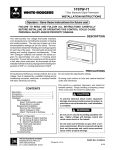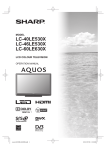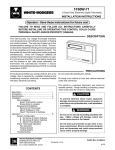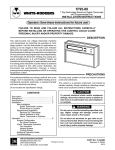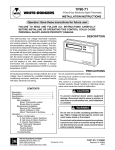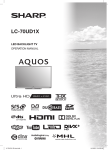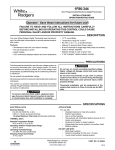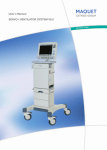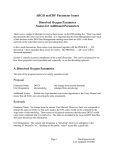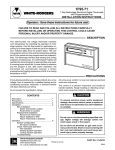Download White Rodgers 1F97W-51 Specifications
Transcript
1F97W-51 7-Day Electronic Digital Thermostat WHITE-RODGERS INSTALLATION INSTRUCTIONS Operator: Save these instructions for future use! FAILURE TO READ AND FOLLOW ALL INSTRUCTIONS CAREFULLY BEFORE INSTALLING OR OPERATING THIS CONTROL COULD CAUSE PERSONAL INJURY AND/OR PROPERTY DAMAGE. DESCRIPTION This wall-mounted, low voltage thermostat maintains room temperature by controlling the operation of heating and cooling systems. The user may program up to four time/temperature settings per 24 hour period. The thermostat stores independent heating and cooling programs for each day of the week. The thermostat will store both heating and cooling programs simultaneously. Three “AA” Energizer® batteries will maintain the stored program for approximately one year, if incoming power should fail. If power failure is extensive and the program is lost, after power restoration, the thermostat will automatically maintain a factory preprogrammed heating temperature of 64°F or a cooling temperature of 82°F. PRECAUTIONS If in doubt about whether your wiring is millivolt, line, or low voltage, have it inspected by a qualified heating and air conditioning contractor, electrician, or someone familiar with basic electricity and wiring. Do not exceed the specification ratings. All wiring must conform to local and national electrical codes and ordinances. This control is a precision instrument, and should be handled carefully. Rough handling or distorting components could cause the control to malfunction. CONTENTS ! CAUTION Description ......................................................... 1 Precautions ........................................................ 1 Specifications ..................................................... 2 Installation .......................................................... 2 New Installation Select Thermostat Location Route Wires to Location Replacement Installation Remove Old Thermostat Attach Subbase to Wall Attach Thermostat to Subbase Operation ........................................................... 6 System Configuration Electric Heat Systems Energy Management Recovery (EMR) Check Thermostat Operation Fan Operation Heating System Cooling System Troubleshooting R WHITE-RODGERS DIVISION EMERSON ELECTRIC CO. 9797 REAVIS ROAD ST. LOUIS, MISSOURI 63123-5398 To prevent electrical shock and/or equipment damage, disconnect electric power to system at main fuse or circuit breaker box until installation is complete. ! WARNING Do not use on circuits exceeding specified voltage. Higher voltage will damage control and could cause shock or fire hazard. Do not short out terminals on gas valve or primary control to test. Short or incorrect wiring will burn out thermostat and could cause personal injury and/or property damage. PART NO. 37-5093B Printed in U.S.A. Replaces 37-5093A 9531 SPECIFICATIONS ELECTRICAL DATA Electrical Rating: 17 to 30 VAC 50/60 Hz. 0.05 to 1.5 Amps 1.5 Amps Maximum Total Load (All terminals combined) Anticipation: Heating 2 to 40 Reference Values Cooling 4 to 40 } THERMAL DATA Setpoint Temperature Range: 40°F to 99°F (4°C to 37°C) Operating Ambient Temperature Range: 32°F to 105°F Operating Humidity Range: 0 to 90% RH (non-condensing) Shipping Temperature Range: -40°F to 150°F APPLICATIONS For use with: • Standard heat/cool, heat-only, or cool-only systems • Electric heat systems • Gas or oil fired systems • Gas systems with intermittent ignition devices (I.I.D.) and/or vent dampers Do not use with: • Multi-stage systems • Heat pump systems • Systems exceeding 30 VAC and 1.5 Amps ACCESSORIES Thermostat Guard W. R. Part No. F29-0198 (clear) or F29-0238 (opaque) INSTALLATION NEW INSTALLATION You should program the thermostat with batteries installed before attaching on subbase. See OPERATION GUIDE for programming instructions. SELECT THERMOSTAT LOCATION Proper location insures that the thermostat will provide a comfortable building temperature. Observe the following general rules when selecting a location: 1. Locate thermostat about 5 ft. above the floor. 2. Install thermostat on a partitioning wall, not on an outside wall. 3. Never expose thermostat to direct light from lamps, sun, fireplaces or any temperature radiating equipment. 4. Avoid locations close to windows, adjoining outside walls, or doors that lead outside. 5. Avoid locations close to air registers or in the direct path of air from them. 6. Make sure there are no pipes or duct work in that part of the wall chosen for the thermostat location. 7. Never locate thermostat in a room that normally warmer or cooler than the rest of the building. 1. Probe for obstructions in partition before drilling 1⁄2” hole in wall at selected location. Take up quarter round and drill a small guide hole for sighting (see fig. 1). From basement, drill 3⁄4” hole in partition floor next to guide hole. In buildings without basements, drill 1⁄2” hole through ceiling and into partition from above. 2. Through this hole drop a light chain, or 6” chain attached to a strong cord. Snag cord in basement with hooked wire. In buildings without basements, drop cord through hole in ceiling and down partitioning; snag cord at the thermostat location. 3. Attach thermostat wire to cord and pull wire through hole in wall so that 6” of wire protrudes. 1⁄2” hole for thermostat wire Stout cord with 6” chain attached Approximately 5 feet from floor Baseboard strip moulding 1⁄4” guide hole for sighting Quarter round removed 8. Avoid locations with poor air circulation, such as behind doors or in alcoves. ROUTE WIRES TO LOCATION NOTE All wiring must conform with local and national electrical codes and ordinances. 2 3⁄4” hole in floor of partition Hooked wire for snagging chain Figure 1. Routing thermostat wires REPLACEMENT INSTALLATION REMOVE OLD THERMOSTAT 1. Shut off electricity at the main fuse box until installation is complete. Verify power is off with a voltmeter. TABLE 1. OLD THERMOSTAT IDENTIFICATION OLD THERMOSTAT TYPE Type 1 2. Remove the front cover of the old thermostat. With wires still attached, remove wall plate from the wall. Type 2 Type 3. If the old thermostat has a wall mounting plate, remove the thermostat and the wall mounting plate as an assembly. 3 Type 4. FOR HEATING ONLY SYSTEMS — Disconnect the two wires from the old thermostat. Skip steps 5 through 7 below and proceed to ATTACH SUBBASE TO WALL. 5. FOR HEATING/COOLING SYSTEMS — Before removing wires from old thermostat, identify the terminals that have wires attached on the old thermostat. Then use Table 1 to identify the type of thermostat you are replacing. For example, if the old thermostat has wires attached to terminals R, W, Y, and G, the old thermostat is a type 5 (note that the old thermostat may not have wires attached to all the terminals identified in Table 1). 6. Use the self-adhesive labels enclosed with your new thermostat to identify the wires attached to the old thermostat. The labels correspond to the thermostat type number you identified in step 5 above (see Table 2). For example, if you determined that the old thermostat is a type 5, use the labels for the type 5 thermostat (you may not use all the labels for the type number you’ve identified if the old thermostat did not have wires attached to all the terminals). 4 Type 5 OLD THERMOSTAT TERMINAL IDENTIFICATION 4 W RC Y G RH W RC Y G M H V C F R5 4 Y6 G R W Y G TABLE 2. WIRE IDENTIFICATION LABELS Type 1 New Old New Old New Old New Old New Old RH 4 W W RC RC Y Y G G Type 2 New Old New Old New Old New Old New Old RH RH W W RC RC Y Y G G Type 3 New Old New Old New Old New Old New Old G F RH M W H RC V Y C Type 4 New Old New Old RH R5 W 4 New Old New Old Y Y6 G G Type 5 New Old New Old RH R W W New Old New Old Y Y G G 7. Label each wire as you disconnect it. The labels have both the old terminal markings and the new terminal identification. Discard any unused labels. PULL AT LEAST SIX INCHES OF WIRE OUT OF THE WALL WHEN YOU DISCONNECT IT - DO NOT ALLOW THE WIRES TO FALL BACK INTO THE WALL. ATTACH SUBBASE TO WALL 1. Remove the packing material from the thermostat. Place the fingers of one hand on the center top and bottom portion of the thermostat. Grasp the subbase in the other hand on the top and bottom center, and gently pull straight out (see fig. 2). The thermostat has pin and socket connectors. Forcing or prying on the thermostat will cause damage to the unit. 2. Pull wires through opening in the center of the subbase. DO NOT LET WIRES FALL BACK INTO WALL. 3. Connect wires beneath terminal screws on subbase using appropriate wiring schematic (see figs. 3 through 8). 4. Place subbase over hole in wall and mark mounting hole locations on wall using subbase as a template. PULL STRAIGHT OUT Figure 2. Removing thermostat from subbase Screw anchors Connect wires under terminal screws Mounting hole W 6-pin connector RC G Activity light Mounting hole Y RH 2-pin connector Pull wires through this opening (Installation instructions continue on page 5.) Figure 3. Subbase 3 NOTE ! CAUTION All wiring diagrams are for typical systems only. Refer to equipment manufacturers’ instructions for specific system wiring information. To prevent electrical shock and/or equipment damage, disconnect electrical power at the main fuse box or circuit breaker until installation is complete. From heating system From 24 VAC transformer THERMOSTAT Y G W RC W RH SYSTEM W RC G Heating System Hot 24 VAC Y RH 120 VAC RH Neutral Thermostat Terminal Connections TRANSFORMER Figure 4. Typical wiring diagram for heat only, 2-wire, single transformer systems From 24 VAC transformer JUMPER WIRE From heating system THERMOSTAT Y G W RC W RH W SYSTEM RC G NOTE Fan Relay RED jumper wire (provided with thermostat) must be connected between thermostat's RH and RC terminals for proper thermostat operation with this system. Heating System G Hot 24 VAC 120 VAC Y RH RH From fan relay CONNECT red jumper wire (provided) Neutral TRANSFORMER Thermostat Terminal Connections Figure 5. Typical wiring diagram for heat only, 3-wire, single transformer systems From 24 VAC transformer THERMOSTAT Y G W RC W RH SYSTEM Cooling System Fan Relay RC Hot 24 VAC 120 VAC Neutral TRANSFORMER G RC G Y RH From fan relay From cooling system Thermostat Terminal Connections Figure 6. Typical wiring diagram for cool only, 3-wire, single transformer systems 4 Y From heating system CONNECT red jumper wire (provided) JUMPER WIRE THERMOSTAT Y G W RC RH SYSTEM NOTE RED jumper wire (provided with thermostat) must be connected between thermostat's RH and RC terminals for proper thermostat operation with this system. Cooling Fan Heating System Relay System Hot 24 VAC 120 VAC Neutral TRANSFORMER W W G RC G Y RH RH Y From fan relay From cooling system From 24 VAC transformer Thermostat Terminal Connections Figure 7. Typical wiring diagram for heat/cool, 4-wire, single transformer systems THERMOSTAT Y G W RC RH NOTE This system does not require RED jumper wire (provided with thermostat). Cooling System Fan Relay From heating system From 24 VAC cooling transformer Heating System 24 VAC SYSTEM W Hot RC 120 VAC G Y Neutral HEATING TRANSFORMER Hot 24 VAC 120 VAC Neutral COOLING TRANSFORMER RH W RC G Y From fan relay RH From cooling From 24 VAC system heating transformer Thermostat Terminal Connections Figure 8. Typical wiring diagram for heat/cool, 5-wire, two-transformer system 5. Move subbase out of the way. Drill mounting holes. 6. Fasten subbase loosely to wall, as shown in fig. 3, using two mounting screws. Place a level against bottom of subbase, adjust until level, and then tighten screws. (Leveling is for appearance only and will not affect thermostat operation.) If you are using existing mounting holes, or if holes drilled are too large and do not allow you to tighten subbase snugly, use plastic expansion plugs to secure subbase. 7. Push excess wire into wall and plug hole with a fireresistant material (such as fiberglass insulation) to prevent drafts from affecting thermostat operation. To attach thermostat to subbase, line up the plastic snap guides at the bottom of the thermostat and the two connector pins on the thermostat with the connectors near the bottom left section of the subbase (when viewed from the front). Gently pivot the thermostat up until the six pin connectors and the plastic snaps lock into place (see fig. 9). Be gentle when attaching thermostat. If the thermostat does not seem to be attaching to the subbase easily, make sure that the connector pins and plastic snaps are properly aligned, and that excess wire is pushed into the wall. Damage to the thermostat may occur if force is used. ATTACH THERMOSTAT TO SUBBASE ! CAUTION USE SYSTEM TO TURN THERMOSTAT OFF BEFORE ATTACHING THERMOSTAT TO WALL. FAILURE TO TURN OFF THERMOSTAT BEFORE ATTACHING MAY CAUSE EQUIPMENT DAMAGE DUE TO RAPID COMPRESSOR CYCLING. HEAT - OFF - COOL ENGAGE TWO LOWER GUIDES; PIVOT UP Figure 9. Attaching thermostat to subbase 5 OPERATION SYSTEM CONFIGURATION 6-pin Connector Batteries ELECTRIC HEAT SYSTEMS W14 NOTE ENERGY MANAGEMENT RECOVERY (EMR) When the EMR feature is activated, the thermostat’s microcomputer automatically calculates the time it will take to change the temperature to the next program setting. Then the thermostat will energize the heating or cooling system to change the temperature so that the desired temperature is reached at or near the beginning of the next program period (the thermostat’s microcomputer calculates 15 minutes for every 2°F temperature change). For example, assume that the thermostat is programmed to provide an overnight heating temperature of 62°F, and during the next program period, scheduled to begin at 6:00 AM, the programmed temperature is 70°F. With EMR activated, the thermostat will automatically energize the heating system at 5:00 AM, so that the programmed temperature of 70°F is reached by about 6:00 AM. The thermostat is shipped with the EMR feature inactive, which means that the thermostat will energize the heating or cooling system at, not before, the beginning of the program period (real time). To activate the EMR function, clip wire S3 on the back of the thermostat (see fig. 10). 6 S3 For central electric heat systems where the blower is energized by a separate circuit through the fan relay (meaning that the fan turns on immediately on call for heat), clip wire W14 on the back of the thermostat (see fig. 10). If the thermostat is energizing electric heat sequencers, DO NOT clip wire W14. 2-pin Connector Figure 10. Back of thermostat CHECK THERMOSTAT OPERATION If at any time during testing the system does not function correctly, disconnect electrical power at the main fuse or circuit breaker and check that all wiring is correct. FAN OPERATION 1. Turn on power to the system. If the heat source has a standing pilot, be sure to light it. 2. Press FAN until FAN ON is displayed. The blower should begin to operate (this will work only on systems where the G terminal is connected to the blower relay). ON - AUTO FAN 3. Press until FAN AUTO is displayed. The blower should stop operating within approximately one minute. ON - AUTO HEATING SYSTEM OPERATION 1. Press SYSTEM until HEAT is displayed (it may already be displayed). HEAT - OFF - COOL 2. Press to adjust thermostat above room temperature to call for heat. The heating system should begin to operate. COOLING SYSTEM OPERATION ! CAUTION To prevent compressor and/or property damage, if power to the compressor has been off or interrupted for more than 1 hour and the outdoor temperature is below 50°F, DO NOT operate the system for at least the amount of time the compressor was off! This will allow the compressor heaters to warm the compressor oils to avoid damage due to slugging. 1. Press SYSTEM HEAT - OFF - COOL until COOL is displayed. to adjust thermostat below room tem2. Press perature to call for cool. The blower should come on immediately, followed by cold air circulation. However, if the blower does not come on and the word COOL is flashing, the compressor lockout feature is operating (see Lockout Bypass Option to temporarily override the compressor lockout feature during testing). Refer to the OPERATION GUIDE if you need additional information on thermostat operation. LOCKOUT BYPASS OPTION FOR QUALIFIED SERVICE TECHNICIANS’ USE ONLY. OPERATORS SHOULD NOT USE THIS FEATURE DUE TO POSSIBILITY OF EQUIPMENT OR PROPERTY DAMAGE, OR PERSONAL INJURY. COMPRESSOR SHORT TERM CYCLE PROTECTION This thermostat has a built-in short term (5-minute) time delay. During this 5-minute period, the thermostat will lock out the compressor to allow head pressure to stabilize. If you want to override this feature while testing thermostat operation, simply press and VIEW PRGM VIEW TEMP buttons at the same time at initial startup. DO NOT USE THE LOCKOUT BYPASS OPTION UNLESS THE COMPRESSOR OIL HEATERS HAVE BEEN OPERATIONAL FOR 6 HOURS AND THE SYSTEM HAS NOT BEEN OPERATIONAL FOR AT LEAST 5 MINUTES. TROUBLESHOOTING Refer to the Question & Answer section of the OPERATION GUIDE for information on troubleshooting the thermostat. 7 If you need further information about this product, please write to: WHITE-RODGERS Division of Emerson Electric Co. 9797 Reavis Road St. Louis, MO 63123-5398 ATTN: Technical Service Department








